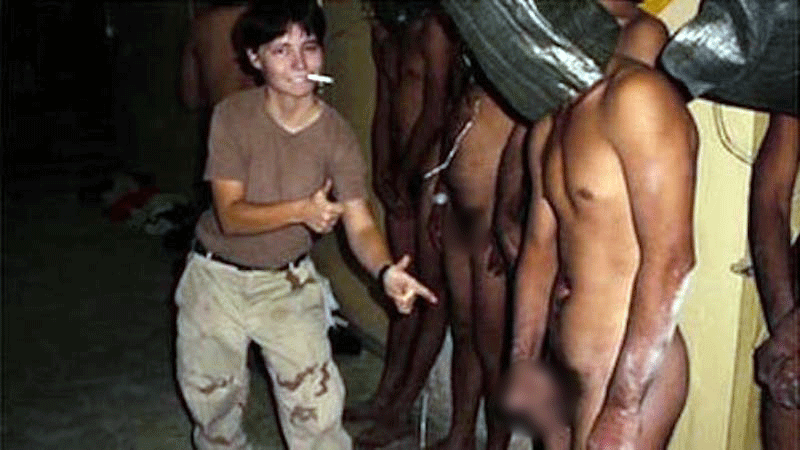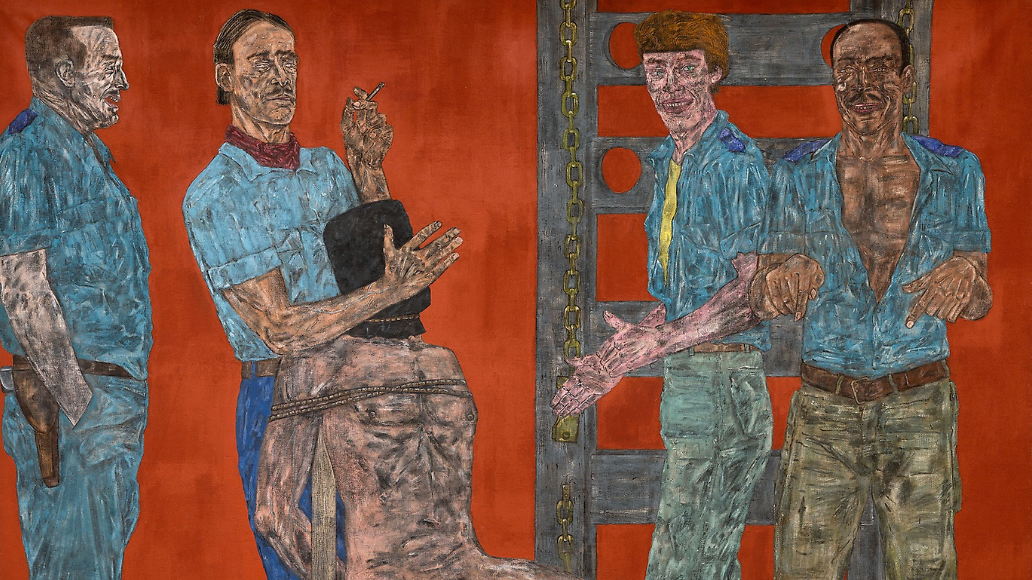With his hand on my upper back my father guided me into a broad, well-lit room full of paintings. Winter: I felt woozy with my jacket on indoors, my mittens dangling from their clips. He brought me before a towering, unstretched canvas that covered the whole wall (Twenty years later, I know the painting’s exact dimensions: ten feet by fourteen feet). The men, against a background of depthless, throbbing orange, stood impossibly tall. My father explained how the painter had used a butcher’s knife to scrape the paint thin as he worked. “And look at the hands,” he said, the hands of the men horsing around, taking a break from torturing the black-hooded victim seated naked in a chair between them. “Aren’t they incredible hands?” We stood in silence. One of the men in the painting looked directly at me. My father squeezed my shoulder to get my attention. “This is what men do to each other,” he said. He looked back down at me, and saw something in my expression, just what I can’t be sure.
“Don’t talk to cops,” he said. And then we quit the room.
The painting is by Leon Golub and titled Interrogation II. He made the piece in 1981, a time in his career when he took to large-scale, unstretched canvas portrayals of the western world’s exported brutality—especially that of the Contras in Nicaragua and the Atlacatl army battalion of El Salvador, both groups bankrolled by the United States. I didn’t know any of that when my father took me to see Interrogation II, but I recognized the truth of his words and of Golub’s work regardless: I knew that that’s what men did to each other because I knew that that’s what boys did to each other. By then, I’d already had my arms held behind my back while my classmates took turns kicking me in the nuts, already had my face held down in the snow while an older boy’s crazed labrador raced in circles around us.
“You see my dog’s dick?” he wanted to know. I remember the red of the dog’s erection. “I’m gonna make him fuck your face.”
My parents had sent me to a hippy-dippy daycare where when someone touched you in a way that displeased you all you had to say was, “That’s my body, and I don’t like that.” But then we moved out to the suburbs and I had to go to elementary school. At recess, some kid hauled off and decked me square in the mouth.
“That’s my body,” I said. “And I don’t like that.”
The boy looked at me like I was the dumbest kid in the history of America.
“I know,” he said.
Then he hit me again.
I remember feeling validation while looking at Golub’s monstrosity. I recognized those smiles. They reminded me that the world’s suffering extends beyond the hell of one’s backyard, that feeling similarly is not the same as being in a similar situation.
The painting stayed with me as I came of age in the Bush years. I was twelve when the World Trade Center fell, a freshman in high school when the American military invaded Iraq, and a senior in college when President Barack Obama walked down the red carpet to announce that SEAL Team 6 had killed Osama bin Laden. That raid took place the day after Obama yukked it up at the White House Correspondents Dinner with Seth Meyers, who joked both about bin Laden’s life in hiding, and Donald Trump’s delusional bid for the presidency.
A year into the Iraq War, photos of American troops gleefully, casually torturing prisoners surfaced; Golub appeared to me once again. Especially when I saw the photo of Private First Class Lynndie England posing with a triumphant smile and a thumbs up as hooded men are forced to masturbate for her and for the camera. Like Golub’s red-scarfed torturer, she’s smoking a cigarette.

I combed through the photos from Abu Ghraib, and like most Americans, felt a horror that gave way to a more rehearsable and thus more durable emotion: smugness. I had opposed the war, in part because of the potential for incidents like these, but Dick Cheney told the world it didn’t matter. At the moment I saw these photos, politics felt both necessary and impossible.
So what else was there? Art.
If political action itself ceased to be a meaningful vehicle for action, then art would step in. And like most liberals, or kids from liberal homes, I figured cruelty to be a problem of information. If only work like Golub’s was more publicized, if only more people could see and feel the truth of it, I thought, then this whole thing could have been avoided. I had such high hopes for an aesthetic resistance, art’s ability to tell the truth, and the truth’s ability to change the world. The Daily Show, Michael Moore, the bevy of music compilations and benefit shows and paintings and drawings and on and on—so many of us believed in the equivalency of “art as politics” and the sacred act of “bringing awareness.”
When I write “cruelty is not an informational problem,” I don’t necessarily mean what my father meant, that this is what men do to each other, the pessimistic argument regarding the barbarity of humanity. On the other hand, there’s the idea that the truth, however hair-raising, remains vulnerable to being press-ganged into more convenient narratives, especially in times of war. The truth of the Abu Ghraib photos, the truth Golub tried to paint, can easily be repurposed into an aesthetic argument for American violence.
The standout archetype in this genre is the “dark knight,” the hero willing to operate in the “shadows” staked out by Bush, Cheney and the rest: those willing to do the dirty work that allows the rest of us to sleep at night. These “gritty” and “real” works paint the world as a chaotic hellhole where evil abounds and so we need the übermenschen of the world to live outside the rule of law on our behalf. We live on the precipice of the Hobbesian “state of nature”—omnium bellum contra omnes, or “the war of all against all”—safeguarded only by those ‘brave’ enough to kidnap, to waterboard, to torture, to kill. We witness the toll that committing war crimes takes on the hero’s psyche; this toll, we are reminded, is one we, the viewer, will never have to bear. This is what men do to each other.
“I’m bad news,” the torturer confides to a detainee at the beginning of Zero Dark Thirty, the Rosetta Stone for the dark knight archetype and this era’s imperial self-perception. The torturer’s name is Dan, and he looks exhausted, and he knows he’s exhausted. But in this scene, he’s all business. Maya, the film’s hero, mucks right in with him. It’s her first time in an “enhanced interrogation” setting. She lets the viewer know she will do whatever it takes to get the job done.
The force of her will to find Osama bin Laden is the central point of the film. She who has lost friends, her personal life, her sense of safety, staked it all on the hunt for Osama bin Laden, has one message: Are you in favor of letting the man responsible for the greatest terrorist attack on American soil since Pearl Harbor go free? She is unhinged, sadistic, irresponsible, and—at the very least—an absolute waste of resources. The film its authority inheres in Maya’s status as perfect sufferer.
It’s a deft move that overpowers the simple psychological task of much political art: indictment. What I once wanted from political art was agitprop, something that would make me the hero of the work, the knower of right and wrong: I am “on the right side of history” because I feel the right feelings (pity, anger) at the right time. Not so dissimilar from the dark knight archetype cooked up by the more assiduous neocons and their stooges.
When Zero Dark Thirty came out, Occupy Wall Street had come and gone and I was living near the poverty line in North Florida, despite having “done everything right.” The film made me feel like a fool. The impotence of art in the face of the vested interests feeding and guiding the war machine made it clear that art couldn’t save me, you, or anything.
I felt betrayed by artists like Golub. I’d walked into the working world a rube, already in the habit of getting conned. The next few years featured me at my most insufferable as I became radicalized. Bitterness, envy, resentment—someone’s lying to you if they tell you these feelings don’t play into the formation of a radical political perspective.
Earlier in the year, Rep. Ilhan Omar took Elliott Abrams, a Reagan-era zombie who’d just been made America’s Special Representative to Venezuela, to task. As assistant secretary of state, Abrams had lied to Congress about the U.S.’s role in funding the Contras. He played a crucial role in downplaying the El Mozote massacre, in which U.S.-trained troops had slaughtered over 800 villagers falsely suspected of being FMLN sympathizers. “I fail to understand,” Omar told him, “why members of this committee or the American people should find any testimony that you give today to be truthful.” Abrams exploded at the indignity of facing scrutiny for his past actions.
Seeing Abrams’ ghoulish visage on my phone screen brought Golub back yet again. I took to my closet and dug out a collection of his early and mid-period work. That night, I asked my partner to leaf through it with me. We took our time talking through each painting. She noticed, as my father had, the hands. Tired, we set the book back in its box and turned off the lights.
As I fell asleep, I realized that my own desire for rectitude and clemency and self-serving confirmation had duped me into missing the essential meaning in Interrogation II. Golub offers no retreat into the life-changing magic of already being the hero. His work doesn’t partake in “shaming-us-into-action-by-unmasking-the-truth-of-our-actions” mode of art-making, as Maggie Nelson calls it. Looking closely at the painting, and others from this period, I began to realize that these works do not concern themselves with the victims or their’ perspective per se. And in that way they subvert both self-righteous pity and self-righteous anger. Golub shifts the perspective towards that of the torturers and mercenaries. It privileges the gaze of the brutalizer, who unlike Dan, or Maya, doesn’t seem terribly worked up about his day job—a taboo gesture, especially now.
Golub’s men emanate pride and humor, like masters of the hunt returning to camp after a good kill. Interrogation II possesses a particularly eerie ordinariness. The torture rack to which the victim is chained suggests they’ve either just taken him down, or haven’t yet put him up. There’s a lull in the cruelty. The men are having fun; the scene is funny, casual, even. Compare this to the victim, twice removed from importance: hooded, he is further obscured by the hand of the cigarette-smoking man, gesturing in conversation. Even if the victim is the occasion for their togetherness, he’s beside the point. The torturers have turned their gaze outward. They are looking at you.






